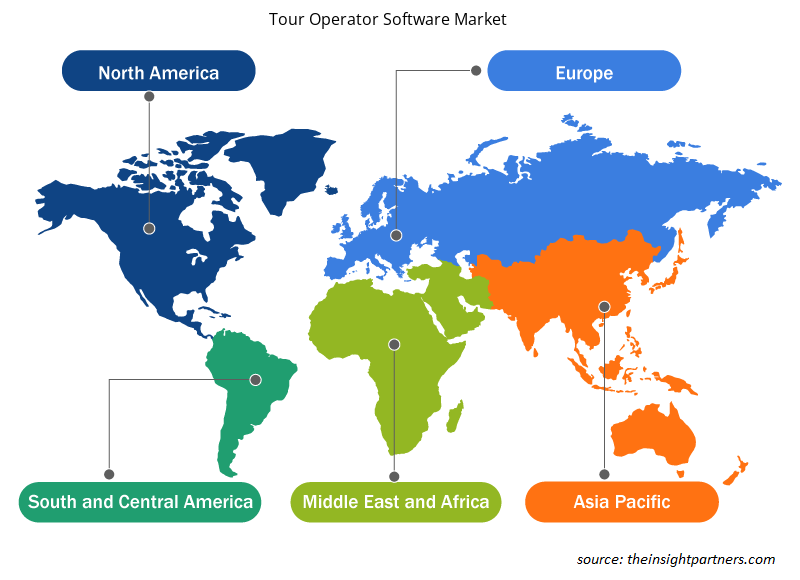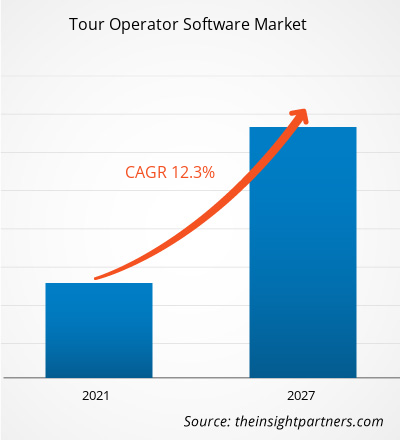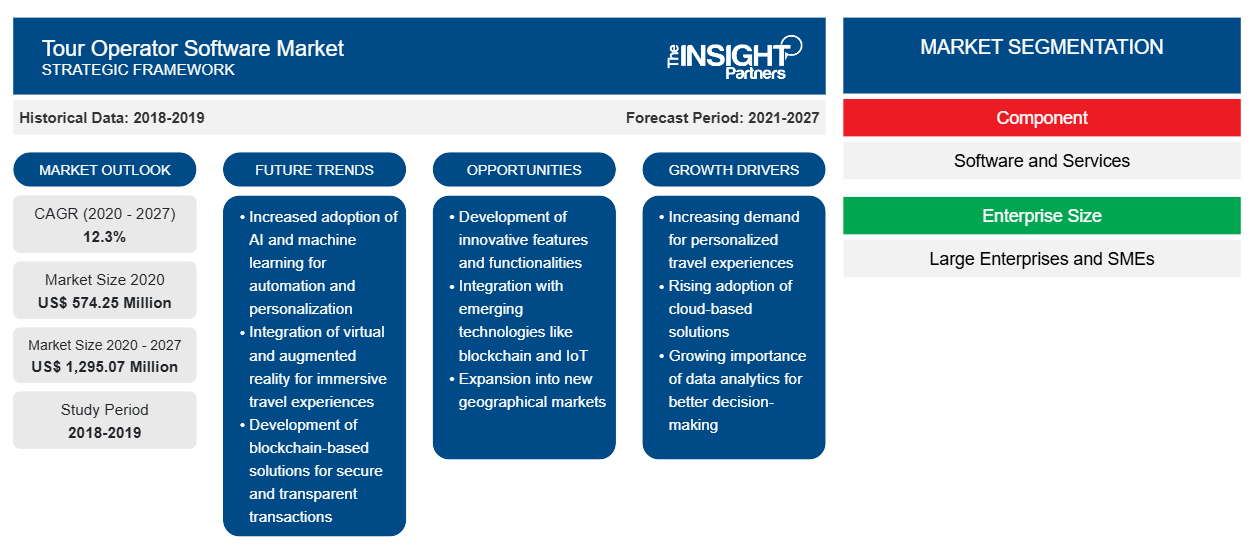旅行社软件市场预计将从 2020 年的 5.7425 亿美元增长到 2027 年的 12.9507 亿美元;预计 2020 年至 2027 年的复合年增长率为 12.3%。
全球旅游业的蓬勃发展和乐观的经济前景推动了市场的增长。旅游业的增长受到 GDP 增长、经济规模、旅游基础设施发展、行业结构、人口和监管政策等因素的影响。这些因素因国家而异,并影响该国的旅游投资。多年来,旅游业发展迅猛,并持续增长。社会各阶层对旅游的需求导致了各种旅游类型的出现,如公路旅游、水路旅游和航空旅游,其中公路旅游长期以来一直占据主导地位。发达国家和发展中国家的群众可支配收入不断增加,导致越来越多的旅行社选择选择有吸引力的优惠来预订旅游。此外,中国和印度等发展中国家的 GDP 增长预计将为未来几年的市场增长提供充足的机会。随着全球经济前景乐观、旅游基础设施投资、中小企业增长、跨境贸易量巨大以及政治环境稳定,预计未来几年全球旅游支出将增加。随着全球化和跨境贸易的增加,旅游支出也在增加。这些因素对旅游运营商软件市场的增长产生了积极影响。
定制此报告以满足您的需求
您可以免费定制任何报告,包括本报告的部分内容、国家级分析、Excel 数据包,以及为初创企业和大学提供优惠和折扣
-
获取此报告的关键市场趋势。这个免费样品将包括数据分析,从市场趋势到估计和预测。
COVID-19 疫情对旅行社软件市场的影响
冠状病毒 (COVID-19) 的出现和迅速蔓延使许多国家陷入瘫痪,包括发达国家和发展中国家。感染患者数量的持续激增威胁着全球多个行业。截至 2020 年 12 月,美国、印度、巴西、俄罗斯和法国是确诊病例和报告死亡人数最多的国家。由于封锁、旅行禁令和企业停业,冠状病毒疫情已影响到各国的经济和行业。由于大多数国家都在实施封锁,这给旅游业带来了负面影响。不同地区政府对国内和国际旅行的临时限制也显示出旅游业的负面趋势。COVID-19 的持续蔓延对旅行社软件市场参与者来说将非常危险。
市场洞察-旅行社软件市场
旅游业越来越多地采用人工智能
人工智能 (AI) 的日益融合,增强了通过运营商预订有吸引力的旅游套餐的整体流程,从而推动了旅行社软件的采用。旅游业采用人工智能和机器人技术,提升了旅行社提供的客户体验和服务。随着人工智能旅游智能的引入,乘客的旅行安排得到了进一步改善,以满足他们的期望。它还提供定制、自动化和富有洞察力的优质旅行服务。人工智能的整合使旅行社能够研究旅行者的兴趣和行为,并提供增强的体验。旅游业的人工智能主要关注客户参与和服务,以进一步提升旅行者的旅行体验。旅游行业的聊天机器人、语言翻译和虚拟现实等新兴人工智能技术正在对旅游、旅游和酒店业产生积极影响。因此,人工智能的日益融合进一步推动了全球旅游业的发展。
基于组件的洞察
根据组成部分,旅行社软件市场分为软件、服务。软件部分在 2019 年占据了最大的市场份额。
旅行社软件市场的参与者主要致力于开发先进、高效的产品。
- 2020 年,GP Solutions GmbH 与 ComBtas 建立了战略合作伙伴关系。该联盟旨在面向以色列市场的客户。通过此次合作,ComBtas 将推广 GP Solutions 的交钥匙产品,包括 GP 旅游企业和 GP 旅游中心。
- 2020 年,Travefy, Inc. 推出了一款面向旅游顾问的网站构建器。该网站构建器使顾问能够创建网站或营销登录页面。该网站构建器使用拖放界面,顾问可以选择主题、自定义内容,还可以使用自定义 URL。此外,该工具包含在订阅计划中。
旅行社软件市场区域洞察
Insight Partners 的分析师已详尽解释了预测期内影响旅行社软件市场的区域趋势和因素。本节还讨论了北美、欧洲、亚太地区、中东和非洲以及南美和中美洲的旅行社软件市场细分和地理位置。

- 获取旅行社软件市场的区域特定数据
旅行社软件市场报告范围
| 报告属性 | 细节 |
|---|---|
| 2020 年市场规模 | 5.7425亿美元 |
| 2027 年市场规模 | 12.9507亿美元 |
| 全球复合年增长率(2020 - 2027 年) | 12.3% |
| 史料 | 2018-2019 |
| 预测期 | 2021-2027 |
| 涵盖的领域 |
按组件
|
| 覆盖地区和国家 |
北美
|
| 市场领导者和主要公司简介 |
|
旅行社软件市场参与者密度:了解其对业务动态的影响
旅行社软件市场正在快速增长,这得益于最终用户需求的不断增长,这些需求源于消费者偏好的不断变化、技术进步以及对产品优势的认识不断提高等因素。随着需求的增加,企业正在扩大其产品范围,进行创新以满足消费者的需求,并利用新兴趋势,从而进一步推动市场增长。
市场参与者密度是指在特定市场或行业内运营的企业或公司的分布情况。它表明在给定市场空间中,相对于其规模或总市场价值,有多少竞争对手(市场参与者)存在。
在旅行社软件市场运营的主要公司有:
- Checkfront 公司
- GP 解决方案有限公司
- 雷兹迪
- 行程安排
- Travefy 公司
免责声明:上面列出的公司没有按照任何特定顺序排列。

- 获取旅行社软件市场顶级关键参与者概览
旅行社软件市场细分如下:
全球旅行社软件市场 – 按组件划分
- 软件
- 服务
全球旅行社软件市场 – 按企业规模
- 大型企业
- 中小企业
全球旅行社软件市场 – 按订阅类型
- 一次性订阅
- 每月订阅
- 年度订阅
全球旅行社软件市场 – 按地区划分
-
北美
- 我们
- 加拿大
- 墨西哥
-
欧洲
- 法国
- 德国
- 意大利
- 俄罗斯
- 英国
- 欧洲其他地区
-
亚太地区 (APAC)
- 日本
- 中国
- 澳大利亚
- 印度
- 韩国
- 亚太地区其他地区
-
中东和非洲 (MEA)
- 沙特阿拉伯
- 阿联酋
- 南非
- MEA 其他地区
-
南美洲 (SAM)
- 巴西
- 阿根廷
- SAM 其余部分
旅行社软件市场 – 公司简介
- Checkfront 公司
- GP 解决方案有限公司
- 雷兹迪
- 行程安排
- Travefy 公司
- 旅遊通
- Trawex 技术私人有限公司
- TrekkSoft(TrekkSoft 集团)
- TRYTN 公司
- Xola 公司
- 历史分析(2 年)、基准年、预测(7 年)及复合年增长率
- PEST和SWOT分析
- 市场规模、价值/数量 - 全球、区域、国家
- 行业和竞争格局
- Excel 数据集
近期报告
相关报告
客户评价
购买理由
- 明智的决策
- 了解市场动态
- 竞争分析
- 客户洞察
- 市场预测
- 风险规避
- 战略规划
- 投资论证
- 识别新兴市场
- 优化营销策略
- 提升运营效率
- 顺应监管趋势























 获取免费样品 - 旅行社软件市场
获取免费样品 - 旅行社软件市场